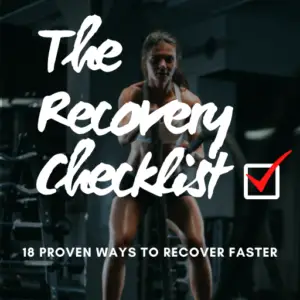I come from a competitive family. When we’re together, we meet physical activity guidelines like we suffer injuries – by accident.
Backyard football games end in arguments and card games devolve to blame games. The only thing more painful than a broken nose…is losing.
So if you’re a fierce competitor like me, you’re about to learn how to get ahead of 77% of Americans every week.
For the more cooperative personalities, you can implement the same habits to enjoy more health, longevity and vitality with your loved ones.
Here’s the sad truth: 77% of Americans do not meet physical activity guidelines.
So what are the physical activity guidelines? And why do so few people meet them?
Do these two things and you will meet physical activity guidelines:
Part 1: Aerobic Exercise
In Part 1, you choose your own (exercise) adventure: either moderate intensity for 150 minutes a week or vigorous intensity for 75 minutes per week.
For example, you can hit your moderate intensity exercise quota with 30 min/day, 5x a week of brisk walking, golfing, gardening, pushing a lawnmower or vacuuming. With all the mowing and vacuuming, your lawn and floors will be immaculate!
Other moderate intensity exercise options include bike riding, hiking, working out on the elliptical and playing pickleball.
Alternatively, opt for vigorous exercise 15 min/day, 5x a week. Vigorous exercise options include circuit training, jumping rope and running on the treadmill.

Part 2: Resistance Training
The second component of physical activity guidelines is resistance training. You don’t need to change careers to professional bodybuilding to meet physical activity guidelines. Simply strength train at moderate intensity, twice a week, targeting major muscle groups.
Like the aerobic exercise recommendations, there’s plenty of flexibility built into this part of the guidelines. You can perform strength training with bands, free weights, weight machines, dumbbells, barbells or your own body weight.
Resistance training builds bone strength and muscle mass in ways aerobic exercise simply cannot. Plus, it reduces injury risk and elevates athletic performance.
Exercise is Medicine
If scientists could shove exercise into pill form, it would be the greatest medication ever created. Because it brings so many benefits with so few downsides.
You’re probably familiar with these well-known benefits of exercise: Heart health. Stronger muscles. Better endurance. Improved body composition. Longer life span.
Here are a few unexpected benefits of exercise than active individuals enjoy. Exercise increases cognitive function, both short-term and long-term. It reduces your risk of cancer by about 25%. It makes you fall asleep faster and sleep deeper.
Furthermore, exercise relieves pain through exercise-induced analgesia. And well-dosed exercise is the most powerful physical therapy treatment in existence. It works just as well as surgery for common conditions like back pain, meniscus tears and rotator cuff injuries.
Last but not least, exercise is amazing for your mental health. Clinical studies show that it eases anxiety and depression symptoms.

Are you in the active minority who gets enough exercise? Or are you missing out on all these benefits?
Start Here
Wondering where to start with exercise? Here are two good options to get on track to meet physical activity guidelines.
Option 1: Start with a fun activity. Perhaps a familiar form of exercise like brisk walking, yard work or hiking. The best exercise routine is one you enjoy. Slowly build up to 75 or 150 minutes of exercise per week and try new activities as you go.
Option 2: Choose from these 7 low-impact exercises and learn the keys to building an exercise habit that sticks.
For more evidence-based health tips, join the free Facts & Physio Newsletter. Plus, get The Recovery Checklist e-book when you sign up.

